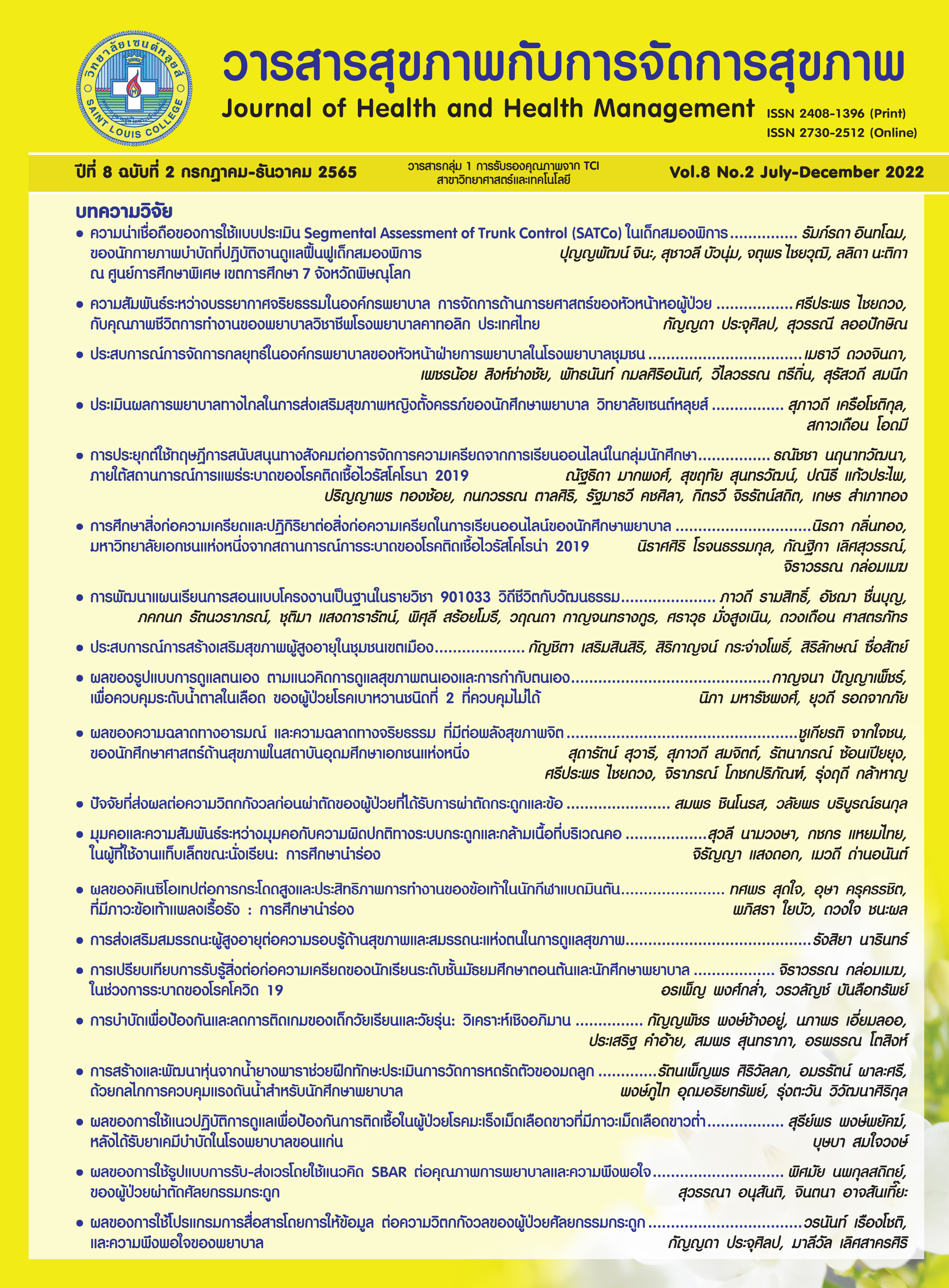An evaluation of telenursing health promotion in pregnancy women by student nurses, Saint Louis College
Keywords:
telenursing, student nurseAbstract
Situation of COVID-19 pandemic, had an effect to nursing education system from practicing onsite in the hospital to conduct via telenursing. Objective of this descriptive research was an evaluation of telenursing health promotion in pregnancy women by student nurses of Saint Louis College. The purposive sample consisted of 50 fourth-year nursing students, who were enrolled in the Maternal- Child Nursing and Midwifery practicum 2 during the second semester of 2020. Research instruments were comprised of 1) demographic data 2) an evaluation of telenursing health promotion in pregnancy women by student nurses: input, process and output and 3) the satisfaction telenursing health promotion in pregnancy women by student nurses. The Index of item Objective Congruence (IOC) was between 0.8 and 1. The reliability of overall questionnaire input, process, output and satisfaction, using Cronbach’s alpha coefficient, were 0.78, 0.86, 0.96 and 0.88 respectively. The data were analyzed by descriptive statistic.The results of this study showed that: the mean of overall input, process and output was at the highest level ( = 3.59, S.D = 0.38;(
= 3.80, S.D = 0.34;(
= 3.64, S.D = 0.34 respectively). Additionally, the student nurses were satisfied with overall telenursing mean at the highest level (
= 3.80, S.D = 0.34). It is suggested that telenursing technology should be used for health promotion amongst pregnant women in clinical areas.
References
กาญจนา ใจจ้อย. (2562). นักศึกษาพยาบาล: การเรียนการสอนที่เน้นผู้เรียนเป็นศูนย์กลาง. วารสารราชธานีนวัตกรรมทางวิทยาศาสตร์สุขภาพ, 2(2), 1 – 11.
จิตตมาศ พุกนาลุ่ม, รตินัฏฐ์ชูทาน, และศิริพร ฉายาทับ. (2562). ปัจจัยที่มีผลต่อการฝึกปฏิบัติในรายวิชาการพยาบาลมารดา ทารกและการผดุงครรภ์ ของนักศึกษาพยาบาล มหาวิทยาลัยราชภัฏนครปฐม. งานประชุมวิชาการระดับชาติครั้งที่ 11 .จังหวัดนครปฐม.
ธานินทร์ ศิลป์จารุ. (2555). การวิจัยและวิเคราะห์ข้อมูลทางสถิติด้วย SPSS และ AMOS (พิมพ์ครั้งที่ 13). กรุงเทพฯ: ห้างหุ้นส่วนสามัญบิสซิเนสอาร์แอนด์ดี.
มาลี คำคง, อฑิภา อมรปิยภากร, รพีภัทร ชำนาญเพาะ, และมุขรินทร์ ทองหอม. (2564). การจัดการเรียนการสอนภาคปฏิบัติการพยาบาลโดยใช้ระบบออนไลน์ในสถานการณ์โควิด-19. วารสารพยาบาลศาสตร์ มหาวิทยาลัยสยาม, 22(43), 114–126.
มาลีวัล เลิศสาครศิริ, และรัตนา พึ่งเสมา. (2564). พฤติกรรมการเรียนของนักศึกษาพยาบาลต่อการเรียนแบบออนไลน์ ช่วงสถานการณ์โควิด-19. วารสารการพยาบาลและการศึกษา, 14(1), 33–47.
ราชกิจจานุเบกษา. (2564). ประกาศสภาการพยาบาล เรื่อง แนวทางการพยาบาลทางไกล (Tele-nursing). สืบค้นจาก: https://www.tnmc.or.th/images/userfiles/files/T_0049.PDF
รุ่งฤดี กล้าหาญ. (2557). ปัจจัยที่ส่งผลต่อผลสัมฤทธิ์ทางการเรียนภาคปฏิบัติของนิสิตพยาบาล ชั้นปีที่3 มหาวิทยาลัยศรีนครินทรวิโรฒ. วารสารพยาบาลทหารบก, 15(3), 412-420.
สมใจ พุทธาพิทักษ์ผล, ปุญทรี พ่วงสุวรรณ และสุมัจฉรา มานะชีวกุล. (2564). รูปแบบการฝึกปฏิบัติการพยาบาลเด็กและวัยรุ่นในระบบการศึกษาทางไกล. วารสารพยาบาล, 70(2), 47-54.
สุภาวดี เครือโชติกุล, และสกาวเดือน โอดมี. (2563). ผลการเรียนรู้แบบบทบาทสมมติต่อการรับรู้สมรรถนะนักศึกษาพยาบาลในวิชาการพยาบาลมารดา ทารกและผดุงครรภ์ 1 วิทยาลัยเซนต์หลุยส์. วารสารสุขภาพกับการจัดการสุขภาพ, 6(2), 28 -39.
อัญชลี ทองเสน, วิวัฒน์ มีสุวรรณ, และดิเรก ธีระภูธร.(2558) .การรักษาทางไกลผ่านเครือข่ายสังคม. วารสารเทคโนโลยีการศึกษาและมีเดียคอนเวอร์เจนซ์, 2(1), 9-15.
Asiri, H., & Househ, M. (2016). The impact of telenursing on nursing practice and education: A systematic literature review. Unifying the applications and foundations of biomedical and health informatics, 105-108.
Bacon, R., Hopkins, S., Kellett, J., Millar, C., Smillie, L., & Sutherland, R. (2022). The benefits, challenges and impacts of telehealth student clinical placements for accredited health programs during the COVID-19 pandemic. Frontiers in Medicine, 9.
Glinkowski, W., Pawlowska, K., & Kozlowska, L.(2013). Telehealth and telenursing perception And knowledge among university students of nursing in Poland. Telemedicine Journal and e Health, 19 (7), 523-529.
Hagan, L., Morin, D., & Lépine, R. (2000). Evaluation of telenursing outcomes: satisfaction, self-care practices, and cost savings. Public Health Nurs., 17(4), 305-13.
Hargreaves, L., Zickgraf, P., Paniagua, N., Evans, T. L., & Radesi, L. (2021). COVID-19 Pandemic impact on nursing student education: telenursing with virtual clinical experiences. SAGE Open Nursing, 7, 23779608211044618.
Jerant, A., Azari, R., Martinez, C., & Nesbitt, T. (2007). A randomized trial of telenursing to reduce hospitalization for heart failure: Patient-centered outcomes and nursing indicators. Home Health Care Services Quarterly, 22(1), 1-20.
Reierson, I.Å., Solli, H., & Bjørk, I.T. (2015). Nursing Students' Perspectives on Telenursing in Patient Care After Simulation. Clinical Simulation in Nursing, 11(4), 244-250.
Smith, T.S., Watts, P., & Moss, J.A. (2018). Using Simulation to Teach Telehealth Nursing Competencies. J Nurs Educ., 57(10), 624-627.
Stufflebeam, D. (2003). The CIPP model of evaluation. In T. Kellaghan, D. Stufflebeam & L. Wingate (Eds.), Springer international handbooks of education: International handbook of educational evaluation. Britain: Kruwer Acadamic Pubbishers.
Downloads
Published
How to Cite
Issue
Section
License
Copyright (c) 2022 Journal of health and health management

This work is licensed under a Creative Commons Attribution-NonCommercial-NoDerivatives 4.0 International License.




